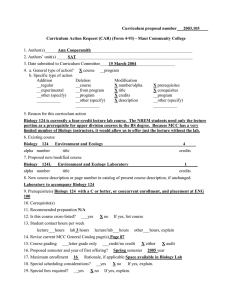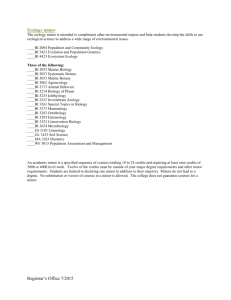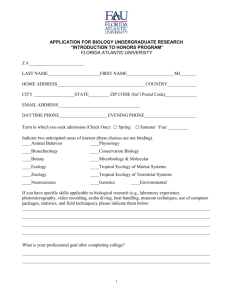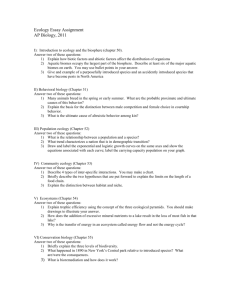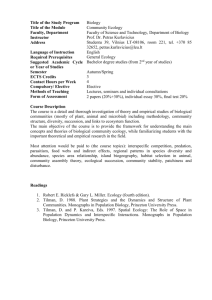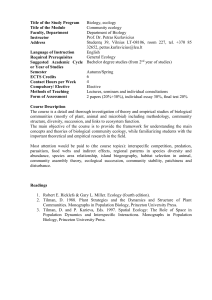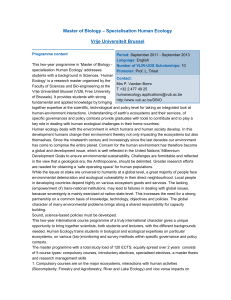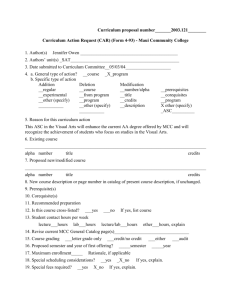2003.104 - BIOL 124 - University of Hawai'i Maui College
advertisement
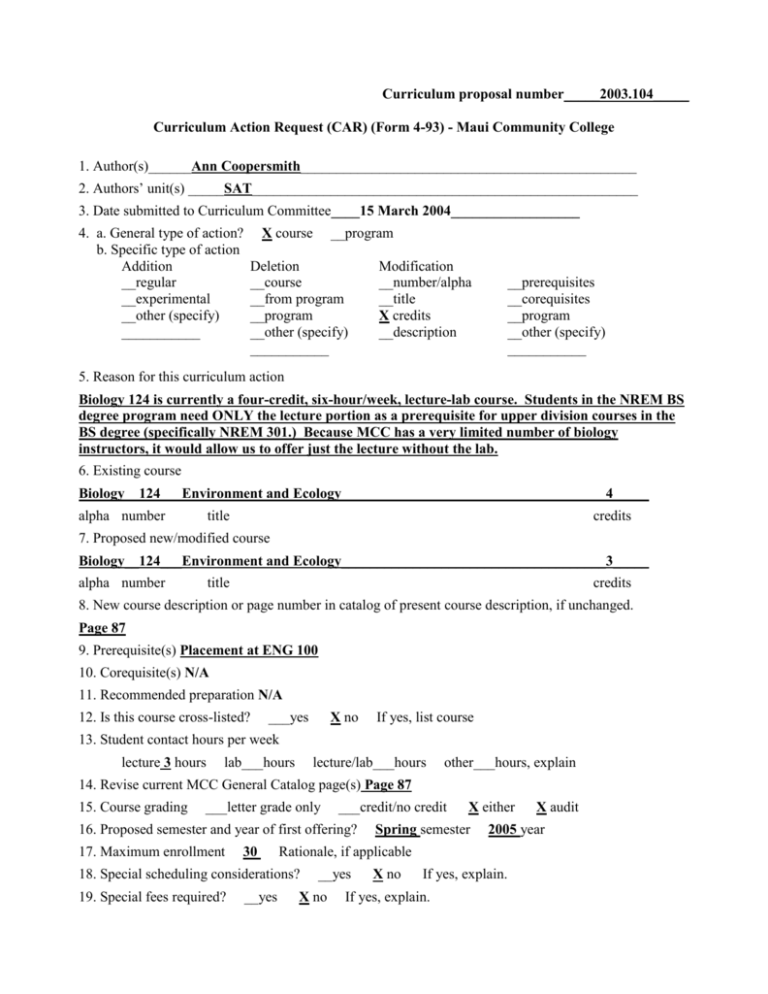
Curriculum proposal number_____2003.104_____ Curriculum Action Request (CAR) (Form 4-93) - Maui Community College 1. Author(s)______Ann Coopersmith_______________________________________________ 2. Authors’ unit(s) _____SAT______________________________________________________ 3. Date submitted to Curriculum Committee____15 March 2004__________________ 4. a. General type of action? b. Specific type of action Addition __regular __experimental __other (specify) ___________ X course __program Deletion __course __from program __program __other (specify) ___________ Modification __number/alpha __title X credits __description __prerequisites __corequisites __program __other (specify) ___________ 5. Reason for this curriculum action Biology 124 is currently a four-credit, six-hour/week, lecture-lab course. Students in the NREM BS degree program need ONLY the lecture portion as a prerequisite for upper division courses in the BS degree (specifically NREM 301.) Because MCC has a very limited number of biology instructors, it would allow us to offer just the lecture without the lab. 6. Existing course Biology__124___Environment and Ecology_____________________________________4_____ alpha number title credits 7. Proposed new/modified course Biology__124___Environment and Ecology_____________________________________3_____ alpha number title credits 8. New course description or page number in catalog of present course description, if unchanged. Page 87 9. Prerequisite(s) Placement at ENG 100 10. Corequisite(s) N/A 11. Recommended preparation N/A 12. Is this course cross-listed? ___yes X no If yes, list course 13. Student contact hours per week lecture 3 hours lab___hours lecture/lab___hours other___hours, explain 14. Revise current MCC General Catalog page(s) Page 87 15. Course grading ___letter grade only ___credit/no credit 16. Proposed semester and year of first offering? 17. Maximum enrollment 30 __yes Spring semester __yes X no X no If yes, explain. If yes, explain. X audit 2005 year Rationale, if applicable 18. Special scheduling considerations? 19. Special fees required? X either 20. Will this request require special resources (personnel, supplies, etc.?) __yes X no If yes, explain. 21. Is this course restricted to particular room type? 22. __yes X no If yes, explain. X Course fulfills requirement for prerequisite for NREM BS upperdivision course program/degree X Course is an elective for AS program/degree X Course is elective for AA degree 23. This course __increases __decreases X makes no change in number of credit required for the program(s) affected by this action 24. Is this course taught at another UH campus? X yes __no a. If yes, specify campus, course, alpha and number LCC & UH-Manoa, Environment & Ecology, Biol 124 HawCC, Introduction to Environmental Science, Sci 124 KapCC & WCC, Technology, Ecology, & Man, Sci 124 UH-Manoa, Environmental Resources: Issues & Options, NREM 210 b. If no, explain why this course is offered at MCC 25. a. Course is articulated at __UHCC __UH Manoa __UH Hilo __UH WO __Other/PCC b. Course is appropriate for articulation at X UHCC X UH Manoa X UH Hilo X UH WO __Other/PCC c. Course is not appropriate for articulation at __UHCC __UH Manoa __UH Hilo __UH WO __Other/PCC d. Course articulation information is attached? X yes __no ....................................................................... Proposed by Approved by ________________________________ Author or Program Coordinator/Date _________________________________ Academic Senate Chair/Date Requested by _________________________________ Division or Unit Chair/Date _________________________________ Chief Academic Officer/Date Recommended by _________________________________ Curriculum Chair/Date Revised Sept 2003/AC _________________________________ Chancellor/Date Maui Community College Course Outline 1. Alpha and Number Biology 124 BIOL 124 Course Title Environment and Ecology Credits 3 Date of Outline 15 March 2004 2. Course Description Examines the biological and physical principles affecting human interactions with the environment. Explores the impacts of science, technology, and values on global ecology. Discusses problems of pollution, overpopulation, and resource depletion with an emphasis on island ecosystems. Evaluates alternatives to current actions and public policies stressing the responsibility of the individual. 3. Contact Hours/Type 3 hours lecture per week 4. Prerequisites Placement at ENG 100 Corequisites Recommended Preparation Approved by __________________________________ Date________________ 5. General Course Objectives Biology 124 is designed to increase knowledge and awareness of environmental issues. This course encourages individual responsibility for environmental protection. It covers scientific concepts in the areas of geography, geology, meteorology, and biology in the context of the natural ecosystems of Hawai‘i. Students will use the scientific method of problem solving and critical thinking skills to analyze current environmental issues and the impacts of humans on natural systems. For detailed information on how Biology 124 focuses on the Maui Community College general education standards, see the attached curricular grid. Biology 124 fulfills four of the 10 credits for the Natural Science requirement for A.A. and A.S. degrees at Maui Community College. This course fulfills the requirements for the University of Hawai’i at Manoa General Education, Diversification, Natural Science, Biological Sciences (D/B.) 6. Student Learning Outcomes For assessment purposes, these are linked to #7. Recommended Course Content. On completion of this course, students will be able to a. describe the biological and physical principles of ecology including ecosystem productivity, major biogeochemical cycles, and energy flow; b. explain and give examples of the impacts of science and technology on global ecosystems; c. identify and explain the dynamics of various kinds of environmental pollution, including water, air, soil, noise, light, debris, and radioactivity; d. explain the basic principles of population dynamics, recent trends in population growth, factors affecting population growth, carrying capacity, consequences of overpopulation on environmental conditions including resource depletion, and methods that can be used to reduce population growth; e. discuss the unique environmental issues that affect island ecosystems, including habitat alteration and destruction, loss of biodiversity, and effects of introduced alien species; f. develop methods for evaluating current actions and public policies that are not environmentally sound; g. discuss and provide supporting evidence for alternatives to current local environmental practices; and h. develop a personal environmental statement and action plan. 7. Recommended Course Content and Approximate Time Spent on Each Topic Linked to #6. Student Learning Outcomes. 1-2 weeks 2-4 weeks 1-2 weeks 2-4 weeks Biological and physical principles related to ecology (a) Environmental pollution (a, b, c) Population ecology (d) Enviromental issues that affect island ecosystems (a, b, c, e) 1-2 weeks 1-2 weeks 1-2 weeks 1-4 weeks Current local environmental practices and public policies (a, b, c, d. e, f ) Alternatives to current environmental actions (a, b, c, e, f, g ) Personal environmental statements (a, b, c, e, f, g, h) Projects (a, b, c, d, e, f, g, h) 8. Text and Materials, Reference Materials, Auxiliary Materials and Content At the time the course is offered, the text(s) and other materials will be selected from the best and most up-to-date materials available at the time, such as Wright & Nebel. 2002. Environmental Science: Toward A Sustainable Future (8th Edition), Prentice Hall. General reference materials, field guides, and videos will be available in the Open Reserve Room at the MCC Library and will include the materials such as those listed at http://kalama.doe.hawaii.edu/hern95/pt009/Ann/124_ref.html 9. Recommended Course Requirements and Evaluation Course requirements will vary with the instructor and should include the following 0-8% attendance 0-50% notes or answers to questions on text assignments, supplemental articles, discussions, guest speakers, videos, DVDs, CDs, network TV programs, etc 0-8% study log 10-90% tests and quizzes 0-60% homework and class activities 0-50% individual and/or group projects, or service-learning projects 10. Methods of Instruction b. c. d. e. f. g. h. i. j. Methods of instruction will vary with the instructor and should include, but not be limited to, the following: a. quizzes and tests with feedback and discussion; class discussions; problem solving and critical thinking activities; narrated 35-mm slide and/or PowerPoint presentations; videos, DVDs, CD-ROMs with detailed viewing guide and discussion questions; guest speakers and attendance at appropriate public lectures; group activities; oral reports and other student presentations; games and simulations; homework assignments such as - reading, or watching, and writing summaries and reactions to environmental issues in the media including broadcast television, newspapers, video, magazines, journals, lectures, web-based material, and other sources; k. l. m. n. o. - reading text and reference materials and answering discussion questions; - researching environmental issues and problems; web-based assignments and activities; reflective journals; group and/ or individual research projects with reports or poster presentations; study logs and study groups; service-learning, community service, and/or civic engagement projects; and p. other contemporary learning techniques (such as problem-based learning, investigative casebased learning, co-op, internships, self-paced programs, etc.)
